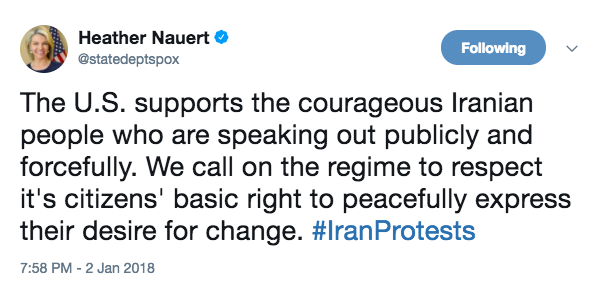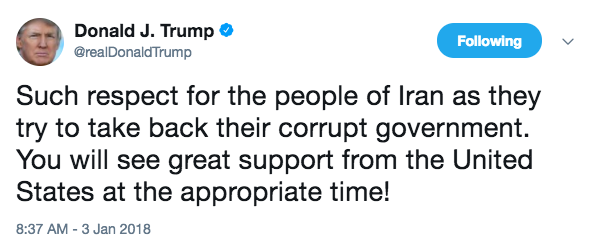As protests continue in Iran, the U.S. State Department has laid out a plan to support the protestors there, as the country sees its seventh day of unrest. The protests started Thursday in Iran’s second largest city and one of Iran’s holiest places, Mashhad, due to the country’s high inflation, economic policies and inequality, and unemployment. The protests have spread to more cities and the message turned more toward regime change.
These are the biggest waves of protests since the nationwide protests in 2009 that the world watched through Twitter.
Steve Goldstein, the Department of State’s Under Secretary for Public Diplomacy and Public Affairs, said the U.S. will post messages in Farsi on Twitter and Facebook so that protestors might be able to communicate, but also to show the United States’ unilateral support, Fox News reported.
Since the protests began last week, the Iranian government has cut off some of the internet to its people, including the most popular communication app in the country, Telegram, and others such as Instagram. It is estimated that half the country uses the messaging app Telegram.
“Even though many social media sites have been blocked, Iranians can reach our State Department [Facebook] and Twitter sites, which are in Farsi, through VPN [virtual private network],” Goldstein said, Fox reported. “We would like Iran to open these legitimate forms of communication.”
This is the country’s biggest political uprising since 2009, and the death toll has already climbed to at least 20 people. Hundreds of people have been arrested, including at least 400 people arrested in the capital, Tehran.
The protests began on Thursday in one city in eastern Iran over extreme price increases of everyday grocery items, and they have since turned into a nationwide movement that is beginning to call for a regime change. Grave violence has broken out, and at least 20 are now dead as the protests continue to spread across Iran.
Heather Nauert, a State Department spokeswoman, also verbalized the United States’ support on Tuesday.
“The U.S. supports the courageous Iranian people who are speaking out publicly and forcefully,” she tweeted. “We call on the regime to respect its citizens’ basic rights to peacefully express their desire for change.”

The U.S. State Department makes a statement about the protests in Iran, January 2018 (Twitter)
And, President Donald Trump on Wednesday again tweeted his support for the protestors.
“Such respect for the people of Iran as they try to take back their corrupt government,” he wrote. “You will see great support from the United States at the appropriate time!”

President Donald Trump support the protestors in Iran, January 2018 (Twitter)
On Sunday, Iranian President Hassan Rouhani noted the people’s right to peacefully protest but warned that security forces would not tolerate vandalism and chaos.
President Trump and the White House have come out in support of the protestors, and they have criticized the Iranian government for sponsoring terrorist groups around the Middle East. Trump also warned that he and the United States are watching for human rights violations, and that the U.S. could impose sanctions if such violations occur.
“The people of Iran are finally acting against the brutal and corrupt Iranian regime,” Trump tweeted on Tuesday morning. “All of the money that President Obama so foolishly gave them went into terrorism and into their ‘pockets.’ The people have little food, big inflation and no human rights. The U.S. is watching!”
Journalist Omid Memarian posted a thread on Twitter that explained what might have sparked this uprising.
In the thread, he says President Rouhani said in December that there are government funds for “various things,” and that “no one knows who’s in charge.”
“There was a long list of 17 different organizations which only took money from the government,” Rouhani said. “We would give them money at the start of the year and when payment was delayed for a day, they would complain about why the government was late.”
“When we asked where the money was spent, they would say: ‘It’s none of your business. You gave us the money. Goodbye! We will spend it anywhere we want,’” he added.
During his speech last year at the United Nations General Assembly, Trump accused Iran of funding terrorists and creating a dangerous missile arsenal. The Iranian President later came out and said flatly that Iran wants to strengthen its missile capabilities – and doesn’t intend to ask permission to do it.
The Iranian nuclear deal was drawn up in 2015 with Iran, the U.S. and five other nations under former President Barack Obama. Its framework includes stipulations that Iran would redesign, convert and reduce its number of nuclear facilities in order to lift nuclear-related economical sanctions, which would reportedly free up billions of dollars in oil revenue and frozen assets for Iran. The U.S. and Iran also agreed to their own terms, along with terms penned with other nations.
President Trump announced in October that the U.S. would not be certifying the nuclear deal this year, and it is now up to Congress to address the deal’s “serious flaws” in order to protect the American people from any threats of nuclear weapons.
Trump said if Congress can’t reach a solution, then the Iran nuclear agreement would be “terminated.”
The President has called the deal “one of the worst” and “the most one-sided transaction the United States has ever entered into,” and he has continually called out Iran for its funding of terrorism.
Trump said the “rogue regime” of Iran is only perpetuating terrorism around the world, and is becoming more aggressive in doing so.
The hostile Iranian regime has not lived up to “the spirit of deal,” which Trump called “deeply controversial.”
“The Iranian dictatorship […] remains the world’s leading state sponsor of terrorism,” the President said, saying the regime provides assistance to al-Qaida, the Taliban, Hezbollah, Hamas and other terrorists.



